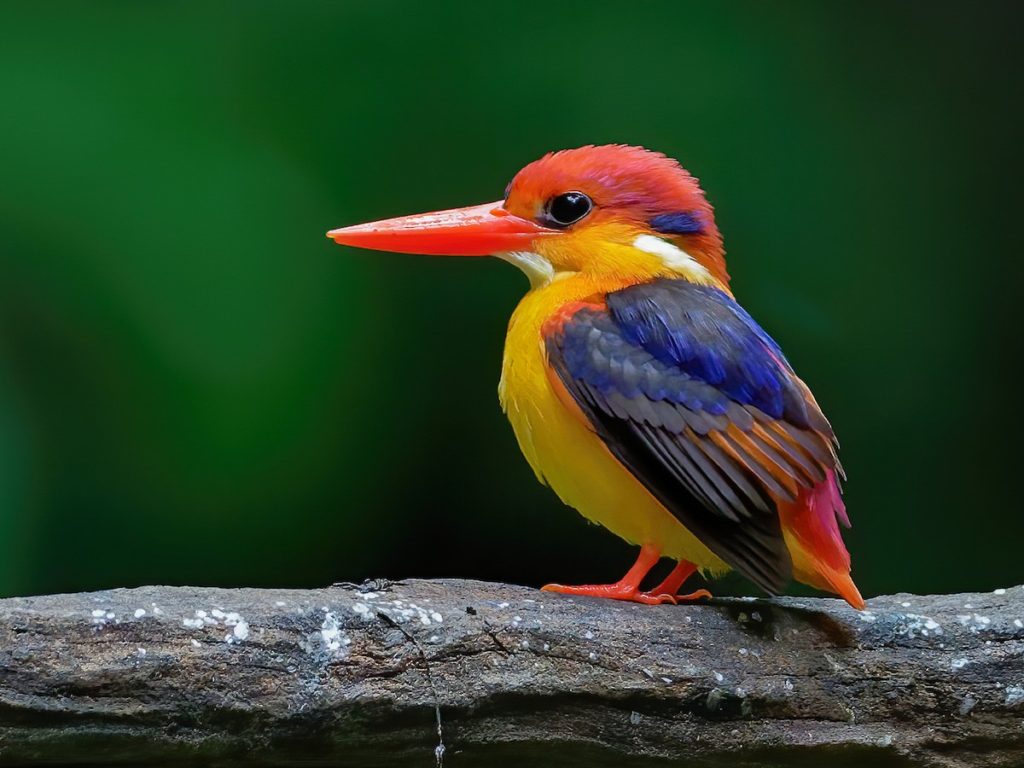Kingfishers of Sri Lanka
Kingfishers are distributed worldwide except in the Polar Regions, high altitudes, and remote islands. They are concentrated in Southeast Asia, New Guinea and tropical Africa. There are 90 species of kingfishers in the world. They belong to the family Alcedinidae which is divided into three…
Kingfishers are distributed worldwide except in the Polar Regions, high altitudes, and remote islands. They are concentrated in Southeast Asia, New Guinea and tropical Africa. There are 90 species of kingfishers in the world. They belong to the family Alcedinidae which is divided into three subfamilies. In Sri Lanka, we have seven species of kingfishers. They are the Common Kingfisher – Alcedo atthis (resident species), Blue-eared Kingfisher – Alcedo meninting (resident species, but very difficult to see), Oriental Dwarf Kingfisher – Ceyx erithaca (resident and a very local species, moderately difficult), Stork-billed Kingfisher – Pelargopsis capensis (resident species), White-throated Kingfisher – Halcyon smyrnensis (resident species), Black-capped Kingfisher – Halcyon pileata (migrant species, arrives in very small numbers, moderately difficult) and Pied Kingfisher – Ceryle rudis (resident species).
Note:The listed price serves as a baseline for our tours. To receive a personalized and accurate quote based on your specific preferences and requirements, kindly book your tour with us, and we’ll be delighted to tailor the experience to your liking.
-
Destination
-
Included
AccommodationAirport TransfersBreakfastDeparture TaxisEntry FeesPersonal Guide
Day 1
Waikkal
Day 2
Wilpattu
- Common Kingfisher Alcedo atthis - possible
- Oriental Dwarf Kingfisher Ceyx erithaca - possible
- Stork-billed Kingfisher Pelargopsis capensis - possible
- White-throated Kingfisher Halcyon smyrnensis - possible
- Black-capped Kingfisher Halcyon pileata - difficult
- Pied Kingfisher Ceryle rudis – possible
Day 3
Wilpattu
-
- Common Kingfisher Alcedo atthis – possible
- Blue-eared Kingfisher Alcedo meninting - very difficult
- Oriental Dwarf Kingfisher Ceyx erithaca - possible
- Stork-billed Kingfisher Pelargopsis capensis - possible
- White-throated Kingfisher Halcyon smyrnensis - possible
- Black-capped Kingfisher Halcyon pileata – difficult
- Pied Kingfisher Ceryle rudis – possible
Day 4
Habarana
-
- Common Kingfisher Alcedo atthis – possible
- Oriental Dwarf Kingfisher Ceyx erithaca - possible
- Stork-billed Kingfisher Pelargopsis capensis - possible
- White-throated Kingfisher Halcyon smyrnensis - possible
- Pied Kingfisher Ceryle rudis - possible
Day 5
Habarana
-
- Common Kingfisher Alcedo atthis – possible
- Blue-eared Kingfisher Alcedo meninting - very difficult
- Oriental Dwarf Kingfisher Ceyx erithaca - possible
- Stork-billed Kingfisher Pelargopsis capensis - possible
- White-throated Kingfisher Halcyon smyrnensis - possible
- Pied Kingfisher Ceryle rudis - possible
Day 6
Kandy
- Common Kingfisher Alcedo atthis – possible
- Oriental Dwarf Kingfisher Ceyx erithaca - possible
- Stork-billed Kingfisher Pelargopsis capensis - possible
- White-throated Kingfisher Halcyon smyrnensis - possible
- Pied Kingfisher Ceryle rudis - possible
Day 7
Kitulgala
- Common Kingfisher Alcedo atthis – possible
- Oriental Dwarf Kingfisher Ceyx erithaca - possible
- Stork-billed Kingfisher Pelargopsis capensis - possible
- White-throated Kingfisher Halcyon smyrnensis – possible
Day 8
Udawalawa
After breakfast at the hotel, proceed to Udawalawe (approximately 04 hours’ drive). Have your lunch at the hotel in Udawalawe. In the afternoon, proceed on a jeep safari in Udawalawe National Park. Species to look out for:- Common Kingfisher Alcedo atthis – possible
- Blue-eared Kingfisher Alcedo meninting - very difficult
- Oriental Dwarf Kingfisher Ceyx erithaca - possible
- Stork-billed Kingfisher Pelargopsis capensis - possible
- White-throated Kingfisher Halcyon smyrnensis - possible
- Black-capped Kingfisher Halcyon pileata – difficult
- Pied Kingfisher Ceryle rudis – possible
Day 9
Kataragama
Proceed on an early morning jeep safari in Udawalawe National Park and afterwards, proceed to Kataragama (approximately 01 ½ hours’ drive). Have your lunch en-route at a local restaurant. Explore Kataragama/Tissamaharama wetlands in the afternoon. Species to look out for:- Common Kingfisher Alcedo atthis – possible
- Blue-eared Kingfisher Alcedo meninting - very difficult
- Oriental Dwarf Kingfisher Ceyx erithaca - possible
- Stork-billed Kingfisher Pelargopsis capensis - possible
- White-throated Kingfisher Halcyon smyrnensis - possible
- Black-capped Kingfisher Halcyon pileata – difficult
- Pied Kingfisher Ceryle rudis - possible
Day 10
Kataragama
With a packed breakfast and lunch, proceed on a full-day jeep safari in Lunugamvehera National Park. Species to look out for:- Common Kingfisher Alcedo atthis – possible
- Blue-eared Kingfisher Alcedo meninting - very difficult
- Oriental Dwarf Kingfisher Ceyx erithaca - possible
- Stork-billed Kingfisher Pelargopsis capensis - possible
- White-throated Kingfisher Halcyon smyrnensis - possible
- Black-capped Kingfisher Halcyon pileata – difficult
- Pied Kingfisher Ceryle rudis – possible
Day 11
Mirissa
After breakfast at the hotel, leave for Mirissa (approximately 02 hours’ drive). Explore the Kirala Kele Sanctuary in the afternoon. Have your lunch at the hotel in Mirissa. Species to look out for:- Common Kingfisher Alcedo atthis – possible
- Blue-eared Kingfisher Alcedo meninting - very difficult
- Oriental Dwarf Kingfisher Ceyx erithaca - possible
- Stork-billed Kingfisher Pelargopsis capensis - possible
- White-throated Kingfisher Halcyon smyrnensis - possible
- Black-capped Kingfisher Halcyon pileata – difficult
- Pied Kingfisher Ceryle rudis – possible























